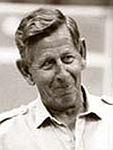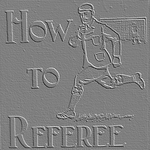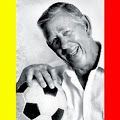 This Video from the... Ken Aston Referee Society -
This Video from the... Ken Aston Referee Society -
 Channel Channel

1. Introduction:
Balls are made in many sizes. There are normal size 5 balls, small size
3 and size 4 balls for youth play, and even smaller "speed" balls for
training. There are weighted balls for indoor play and goalkeeper
training. There are indoor 5-a-side and 6-a-side balls, some fluffy,
some smooth. The most important thing is to know which size is
appropriate for the game in which you are the Referee. Competition rules
(or common sense) usually specify which size can be used. Most players,
parents and coaches do not have a clue which size the ball should be. So
stamp your authority, and just make a decision - don't worry too much if
it is the right decision or the wrong one - after all, both teams will
be using the same ball!
Ball construction materials also vary considerably; as do methods of
manufacture, surface friction and design. Weather and skill will affect
what players can do with specific ball types. A more skilled team will
generally prefer a harder ball - one inflated to the Law maximum. A team
with less skill, will usually prefer a softer ball - even one which is
under-inflated. Cold weather will cause a properly inflated ball to
become soft; conversely, hot whether can cause a ball to become over
inflated. In the 'olden days' leather balls became very heavy during wet
weather, but fortunately, today's waterproof materials enable balls to
remain fairly constant during all types of weather. The very best balls
are hand-sewn leather with a very thin plastic coating that keeps out
the water. I can still remember being 'poll-axed' by a wet leather ball
that hit me like a cannon ball, and knocked me clean off my feet - those
balls were also renowned for giving one or two head aches to the center
backs.
It has been mentioned that the 1996-97 "FIFA Approved" balls' Law change
was nothing more than a fund-raiser for the sanctioning body - but
common sense has prevailed - and now the "FIFA Approved" stipulation
applies to FIFA competition matches organized under the auspices of the
confederations (whatever that means?). Us lesser mortals are now
permitted to use footballs that meet with the minimum technical
requirements stipulated in Law 2. As long as your match is not a "FIFA
Competition", you can use any ball, which meets the requirements of Law
2. In the interests of fairness and safety, you should not use balls
that are noticeably misshapen or have defective panels, or are obviously
too large for your players, or are over or under-inflated. Most players
are only too happy to use the best ball available under the
circumstances. But remember - the Referee is not responsible for
supplying the ball, or for 'pumping them up' to the correct inflation,
so make sure you deal strongly with any moans about the suitability of a
(not quite perfect) ball once a match has started.
2. Quantities and Measurements:
The ball must be:
 - Spherical
- Spherical
 - Made of leather or other suitable material
- Made of leather or other suitable material
 - Of a circumference of not more than 70cm (28ins) and not less than
68cm (27ins)
- Of a circumference of not more than 70cm (28ins) and not less than
68cm (27ins)
 - Not more than 450g (16oz) in weight and not less than 410g (14oz) at
the START of the match
- Not more than 450g (16oz) in weight and not less than 410g (14oz) at
the START of the match
 - Of a pressure equal to 0.6 - 1.1 atmosphere (600 - 1100 g/cm2) above
atmospheric pressure at sea level (8.5 lbs/sq in 15.6 lbs/sq in)
- Of a pressure equal to 0.6 - 1.1 atmosphere (600 - 1100 g/cm2) above
atmospheric pressure at sea level (8.5 lbs/sq in 15.6 lbs/sq in)
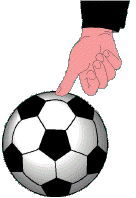
Match balls should be provided by the Home team club and passed to the
Referee in good time before the match starts. The Referee should select
the best of the balls presented to him - for the match ball. Of course,
there will be times when the Home team balls are not fit to use. Use
your common sense and obtain a ball from wherever, to allow the match to
be played. It is not uncommon for Junior clubs to give the ball to the
Referee just before the kick-of, with the result that the game must be
delayed to rectify any faults with the ball. AND invariably the Junior
club does not have a replacement ball or a pump!! The Referee should try
and obtain the match balls in good time before the game starts, so as to
allow sufficient time to rectify any faults.
Check all of the balls before the game starts.
If the match ball is the only ball available during a game, and it
becomes unsuitable, finish the game if at all possible and report to the
authorities.
Try to gain possession of the match ball at the end of each half, and
don’t forget to take the match ball out with you at the start of a game
and at the commencement of half time.
The ball may not be changed during a match without the Referee’s
authority.
3. Replacement of a Defective Ball:
If the ball bursts or becomes
defective during the course of a match:
 - The match is stopped
- The match is stopped
 - Dropping the replacement ball at the place where the first ball became
defective restarts the match. If the ball was out of play when damaged,
restart as normal i.e. goal kick, throw-in etc.....
- Dropping the replacement ball at the place where the first ball became
defective restarts the match. If the ball was out of play when damaged,
restart as normal i.e. goal kick, throw-in etc.....
If the ball bursts or becomes
defective whilst not in play at a kick-off,
goal kick, corner kick, free
kick, penalty kick or throw-in:
 - The match is restarted accordingly
- The match is restarted accordingly
The ball may not be changed during the match without the authority of
the referee.
 - Spare balls should be kept in the technical area during a match, and
must only be used during the match, on the Referee's authority. Try and
use the same match ball throughout the game. If a ball is kicked out of
play and travels some distance from the field of play - use a
replacement ball to keep the game flowing, but replace this with the
original match ball at the earliest occasion and when the ball next goes
out of play.
- Spare balls should be kept in the technical area during a match, and
must only be used during the match, on the Referee's authority. Try and
use the same match ball throughout the game. If a ball is kicked out of
play and travels some distance from the field of play - use a
replacement ball to keep the game flowing, but replace this with the
original match ball at the earliest occasion and when the ball next goes
out of play.
How to recognize a damaged ball:
 - It is usually fairly obvious when a ball is damaged. Players will
soon let you know if there is a problem.
- It is usually fairly obvious when a ball is damaged. Players will
soon let you know if there is a problem.
 - Look for tears, bulges, stitching coming apart, dangerous sharp
plastic coating edges, deformed shape (this usually happens with age) !!
The most common fault is deflation or too much pressure in a ball.
Always carry a football pump with you to games. It is the home teams
responsibility to ensure that balls are OK, but they never seem to have
a pump when you most need it.
- Look for tears, bulges, stitching coming apart, dangerous sharp
plastic coating edges, deformed shape (this usually happens with age) !!
The most common fault is deflation or too much pressure in a ball.
Always carry a football pump with you to games. It is the home teams
responsibility to ensure that balls are OK, but they never seem to have
a pump when you most need it.
 - If during the game a player asks you to check the ball, do so at
the next stoppage in play, unless the damage is obvious of dangerous -
then stop play immediately to inspect the ball.
- If during the game a player asks you to check the ball, do so at
the next stoppage in play, unless the damage is obvious of dangerous -
then stop play immediately to inspect the ball.
 - When a Referee needs to call for a replacement ball during a
match, he firstly blows the whistle to attract the attention of the
officials (or whoever is responsible for providing replacement balls)
and then signals with both arms raised at head height and then downwards
with both hands bowing outwards and then inwards depicting a circle ball
shape in front of him. This is the common method for the Referee to ask
for a replacement ball.
- When a Referee needs to call for a replacement ball during a
match, he firstly blows the whistle to attract the attention of the
officials (or whoever is responsible for providing replacement balls)
and then signals with both arms raised at head height and then downwards
with both hands bowing outwards and then inwards depicting a circle ball
shape in front of him. This is the common method for the Referee to ask
for a replacement ball.
 - If an Assistant Referee spots that the ball is damaged, he needs
to bring this to the attention of the Referee - this should have been
covered in the referees pre-match brief to the Assistant Referee - and
will invariably be at the next natural stoppage of play.
- If an Assistant Referee spots that the ball is damaged, he needs
to bring this to the attention of the Referee - this should have been
covered in the referees pre-match brief to the Assistant Referee - and
will invariably be at the next natural stoppage of play.
+-+ BACK TO TOP +-+
+-+ FIFA-ADDITIONAL +-+
+-+ ADVICE from 'THE PITCH' +-+
Questions and Answers:
This web site and the advice and answers to any questions are not
sanctioned by or affiliated with any governing body of soccer. The
opinions expressed on this site should not be considered official
interpretations of the Laws of the Game. Although the content of the
latest Laws are included on this site, the majority of the content is
the opinion of the Webmaster and other Referees worldwide. If you need
an official ruling you should contact your local
representative/association or visit the FIFA, or the English FA web
sites for the Laws themselves.
Questions and Answers:
Question 1: An attacker
shoots the ball towards goal and the ball bursts as it hits the
crossbar, and crosses the goal line between the goal posts, and a goal
is scored.
What should the Referee do, and how should the game be restarted?
Answer 1: Game must be stopped as soon as the ball bursts (when it hits
the cross-bar). The game to be restarted with a dropped ball on the 6
yard line parallel to where the ball burst on the cross bar. The goal
does not count. The same can be said when the ball bursts on the
crossbar during the taking of a penalty kick. The restart is a dropped
ball.
Question 2: If the ball is stopped or interfered with by an outside
agent, or if it bursts on its way towards the goal whilst a player is
taking a penalty kick, what action should the Referee take?
Answer 2: Law 14 (The Penalty Kick) states that if the ball is touched
by an outside agent, 'the kick is retaken'.
(See also my Question and Answer No. 1 on the Law 12 Sending-Off Off
page.)
Law 2 (The Ball) states that 'If the ball bursts or becomes defective
during the course of a match - the match is stopped - the match is
restarted by dropping the replacement ball at the place where the first
ball became defective. (If the ball was out of play when damaged,
restart as normal i.e. goal kick, throw-in etc..... )'
During the taking of a penalty kick, the ball becomes 'in-play' as soon
as it is touched and moves forward. In this example, the ball was on its
way, and therefore 'in-play'. The correct restart by Law should be a
dropped ball at the place where the first ball became defective during
the taking of the penalty kick. But see my advice below.
If the ball bursts on impact without actually moving forward, then the
ball is NOT in-play - Law 2 (The Ball) states 'If the ball bursts or
becomes defective whilst not in play at a kick-off, goal kick, corner
kick, free kick, penalty kick or throw-in: the match is restarted with
the original restart.'
It would be very difficult for the Referee to identify exactly when a
ball bursts immediately after it has been kicked. My advice here is to
give the benefit of the doubt to the kicker, and retake the penalty
kick. The fact that the impact of the boot on the ball is almost
certainly the catalyst for making the ball burst. The fact that the ball
bursts immediately, or two yards forward from the penalty mark is really
irrelevant. The moment of impact occurs 'out-of' play before the ball
moves, and therefore, the kick should be retaken.
But if the ball hits the goal post and then bursts, and then bounces
back out into the field of play, the restart should be a drop ball on
the goal area line parallel to the goal line, at the point nearest to
where the ball hit the crossbar and burst. In this instance, it was the
crossbar and not the kicker that was the catalyst in making the ball
burst 'whilst it was in-play' after the penalty kick had been taken.
Question 3: How can you tell when a ball is in play, and when it is out
of play?
Answer 3: See my 'Ball out of Play Law 9' page.
Law 9 states that the ball is out of play when it has wholly crosses the
goal line or touchline, irrespective of whether the ball is in the air
or on the ground. The ball is also deemed out of play as soon as the
Referee stops play for any reason. The ball is in play at all other
times including when it rebounds from a goal post, crossbar or corner
flag post and remains on the field of play. The ball is also in play if
it rebounds back onto the field of play from either the Referee or an
Assistant Referee or Club Linesman when they are on the field of play.
The whole circumference of the (complete) ball must cross over the line
before a goal, throw-in, corner kick or goal kick can be awarded. If the
ball is only 3/4 over the line, then it is considered to be still in
play. Players can become very frustrated when they feel that the ball
has wholly crossed the line, and the Referee (or Assistant Referee)
thinks otherwise! Referees are advised to shout play on when this
happens. It can be very frustrating for the Referee also, when players
constantly challenge your eyesight!
Question 4: How many sides does the ball have?
Answer 4: Law 2 states that the ball is spherical, so it can only have 2
sides, inside and outside! Unless you are counting the panels - in which
case, it would be up to the manufacturer of the ball to determine.
You're welcome to count them if you like!
Question 5: During the taking of a throw in, the ball is thrown down
over the touchline, in the air. The ball then curves back out of play
without touching another player. Does the throw in have to be retaken,
or should the throw be awarded to the other side?
Answer 5: As soon as the edge of the ball intersects the plane of the
outer edge of the touchline, the ball is deemed to be in play. If the
ball then leaves the field of play by traveling wholly over the
touchline (either in the air or on the ground), without being touched by
another player, then a throw in should be awarded to the opposing team -
in this case, to the team who were not taking the original throw in. The
ball does not require to be touched by any player after it is thrown
back into play, and before it travels back out of play from a legally
completed throw-in. The throw-in awarded to the opposing team should be
taken from the point where the ball finally left the field of play. The
only instance when the same team would retake a throw-in at the same
place would be if the ball had not properly entered the field of play.
This sometimes happens if the ball slips in the player’s hands, and does
not come into the field of play.
Question 6:A ball kicked towards goal by an attacking player, stops
exactly on top of the goal line. The goalkeeper rushes out and safely
picks up the ball that remains in play. Whilst picking up the ball, the
goalkeeper places both feet behind the goal line, out of the field of
play. The goalkeeper's first action after picking up the ball is to
bring both feet back into the field of play. The Referee ruled that both
the ball and the goalkeeper must have been out of bounds and awarded a
corner kick to the opposing team. Did the Referee make the correct
decision?
Answer 6: Certainly not!
The ball is only out of play when it has wholly crossed the goal
line whether on the ground or in the air. So long as the ball remains in
the field of play, it doesn't matter where the body or the feet of the
goalkeeper are placed. The ball is the only determining factor, and all
that matters is that the ball remains in play. The ball is in play even
if the goalkeeper is laying down outside of the field of play, with only
his hands on the ball inside the field of play. Conversely, if the
goalkeeper had been standing inside the field of play, picked up the
ball that was still in play, and then pulled the ball back behind him
and all the way over the goal line in the motion of throwing the ball
back into play, the ball would have then crossed out of the field of
play, even though the goalkeeper was standing inside. In this case, a
corner kick should be awarded to the opposing team.
Question 7: Why do footballs have multicolored panels?
Answer 7: The ability of a ball to spin is an important part of playing
football. This adds excitement and uncertainty to play, and enables
skilful players to do all sorts of things to alter the trajectory of the
ball whilst it travels through the air. The multicolored panel makes it
easier to see the spin, and gives the texture of the ball more friction
area to create spin. Of course, not all balls are not multicolored; many
are just a single color. The Referee may replace the original ball with
one of a different color if this makes the ball more visible. Orange
balls are sometimes used in snowy circumstances; this allows players
(and television spectators) to see the ball more easily against the
predominant white snowy background. Manufacturers also like to make
their balls unique and recognizable by adding touches of color and
design.
Question 8: During the taking of a penalty kick, the ball deflects off
the goal post and into the goal. The Referee awards the goal and makes
his way back to the center circle for the restart. In the meantime, the
goalkeeper retrieves the ball from the back of the net and notices that
it has become deflated and obviously below the regulation pressure. The
goalkeeper makes his way - with the ball - towards the Referee and hands
him the ball suggesting that the lack of pressure could have helped the
ball squeeze in off the post instead of possibly rebounding back into
play. What should the Referee do?
Answer 8: The Referee obviously had no idea whether the ball burst
before or after the penalty kick was taken. Therefore, the goal must be
allowed to stand. The ball should be replaced or re-inflated to the
correct pressure, before play can recommence. If the Referee did not
observe that the ball had burst before or during the penalty kick then
he has no option but to award the goal and restart with a new ball. The
Referee can only assume that the ball became defective sometime after
the goal was scored. To allow the kick to be retaken under these
circumstances would open the door for dishonest players to burst the
ball out of site of the Referee and then claim a retake of the penalty
kick. The Referee, with the help of his Assistant Referees, is the sole
arbitrator as to when the ball is deemed to have burst or become
deflated, and whether a goal is allowed or not.
Question 9: How can you tell if a ball is spherical or not?
Answer 9: Throw the ball into the air with a spin on it. The ball should
rotate and spin evenly. Roll the ball along an even flat floor and watch
for irregularities. If you detect a wobble, you've probably got a
defective ball. Most of us are capable of using our eyes to see if a
ball is spherical or not. A ball can become misshapen during the course
of a game, so Referees will need to react to any queries emanating from
players about the irregularity of the ball. Players are very quick at
detecting when a ball is not behaving, as it should do. It's a pity that
they do not detect so quickly when they have breached the Laws!
If the ball is becomes heavy on a wet field, or the ball appears to be
out of shape or wobbling, Referees are often very receptive to a polite
suggestion to change balls. Similarly, the Referee will listen to
suggestions at half-time that the ball has become "a bit flat" and will
test the ball and apply some more air if needs be.
Question 10: Are there any types of balls that a Referee should
specifically avoid using?
Answer 10: Any ball that could be deemed unsafe or dangerous to the
players must be avoided. It is very obvious when a ball is dangerous.
The usual problem is damage to the outer plastic covering, which becomes
jagged, with sharp edges sticking out from the surface of the ball. Some
people object to balls manufactured by the use of child labor (from
manufacturers who openly and wrongly guarantee that their products are
made by adults). It is very difficult to ascertain the manufacturing
origin of footballs, but any such manufacturers should immediately be
given the RED card and a permanent suspension!
Question 11: Do managers, coaches or players have the right to insist on
a ball change?
Answer 11: The Referee is the sole judge as to the suitability of the
ball(s). As long as the ball meets all the requirements of the Law 2,
then the ball should be retained. All decisions as to which ball is to
be used, or when a ball should be changed, are the Referees prerogative
- and nobody else's. Managers, coaches or substitutes should not attempt
to change the match balls or alter the inflation without the Referee's
prior approval. This could be considered as gamesmanship that could lead
to disciplinary action being taken against the perpetrators. Some teams
will also use the excuse of a 'supposed' defective ball, to try and
waste time during the closing minutes of the game in which they are
winning - Referees will need to be aware of such unsporting tactics.
Most referees will not take offence to comments like "Ref., the ball
feels a bit hard / soft"
The Referee prior to game commencing should test sufficient balls. These
spare balls should be retained in an agreed position (usually in the
technical area) to enable play to recommence should the match ball be
lost or become unobtainable. Most Referees will insist on a spare ball
being kept somewhere handy, in order to expedite restarts. There are
occasions at many grounds, where balls are retained at strategic points
around the field of play. For instance, there are grounds near, or
alongside rivers, where the ball is very often lost in the water. And
housing with high or sometimes impenetrable fences - making it
impossible to rescue any wayward balls quickly, surrounds more than
often, Park grounds. In such circumstances, spare balls will be kept in
strategic locations, to enable play to be restarted quickly, or to avoid
players having to chase down the road amongst traffic, for rolling
balls!
Have you ever wondered why nearly all grounds are built on the top of
hills, so that balls leaving the field of play always seem to roll about
ten times further than they should!! And players never want to retrieve
them - they always expect somebody else to run after the ball! Or what
about the player who purposefully walks at a snail's pace to retrieve a
ball that has gone some 50 yards outside of the field of play - but as
soon as play has restarted, they are running around like headless
chickens!
If 'ball boys' (or ball persons) are available, the Referee or Fourth
Official should be aware of them before commencement of the match. Ball
persons must serve both the teams equally. In other words, the ball must
be returned to both teams with the same urgency. Referees, Assistant
Referees, and Fourth Officials must also ensure that extra balls do not
enter the field of play during the course of the match. When this
happens, common sense dictates whether the Referee needs to stop play or
not to rid the extra ball from the filed of play.
It has also been noticed, that when a team has a player who is capable
of throwing the ball a large distance, strategic towels are sometimes
placed around the field of play, to enable this throwing player to dry
his hands and gain extra purchase to enable the ball to be thrown
further into the penalty area during wet weather. I see this as an
unfair advantage, and against the spirit of the game. (See my Law 18 -
Common Sense page).
Question 12: Is the ball considered to be an object when it is used to
strike an opponent?
Answer 12:Yes, and the perpetrator should be punished accordingly by
the Referee, depending on the severity of the projected ball..
Question 13: Can additional balls be placed around the field of play for
use during the match?
Answer 13:Provided the balls meet the requirements of Law 2 and are
under the control of the Referee - then the answer is yes.
Question 14: During the taking of a corner kick, if an outside agent on
the field of play catches the ball without being touched by another
player, what action should the Referee take?
Answer 14: The Referee should stop play, and restart with a dropped ball
at the place where the ball was at the time the match was stopped.
|
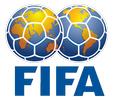


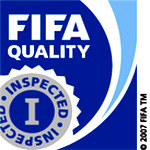 -
- 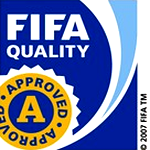 -
- 


